This is what happens when science is done by governments and companies dedicated to the end result.
ITER and so many other projects are littered with graft and hampered by corruption and uninterested governments.
If China can build a reactor with a Q of 10, it’s game over. The west is already getting lapped on solar and EV’s.
We’re gonna be a backwater with a bunch of bombs. Buckle up y’all.
If China can build a reactor with a Q of 10
Unfortunately, that’s scientific Q and not engineering Q. The difference is that scientific Q is the ratio of energy output of the plasma to the energy input of the lasers
Capturing the energy output of the plasma, converting it into electricity, and putting in energy for the lasers are all horrifically inefficient processes.
Previous tokamaks have shown that even a scientific Q of 1 only actually means an engineering Q of roughly 1% (meaning electricity output is 1% of electricity input).
That doesn’t however mean that fusion reactors can’t become viable (in the engineering sense) for many more decades. With Q above 1, it becomes a lot easier to increase Q further (which is why it took so long to get to Q above 1, and now all of a sudden new companies are talking about jumping straight to Q above 10).
Unfortunately, even if you create a fusion reactor that produces net energy, that doesn’t mean that it becomes cheaper than solar energy for a long time. And even if it becomes cheaper than solar energy (like solar energy energy became cheaper than coal), it will take a long time before fusion reactors spread, given how capital and technology intensive they are.
it will take a long time before fusion reactors spread, given how capital and technology intensive they are.
Part of that is the research cost and yes, it could be that when we finally get one made it turns out that the price to have something decent is very high.
But it could also be that when we finally have one or a few fusion reactors selling energy that new research done on them and things like AIs that can run new reactors by being trained on existing reactors data could drive efficiency up so much that by the tenth or twentieth reactor low cost reactors could already have been developed that might have a cost per construction close to or even less than equivalent power with other means as well. Even if they weren’t as efficient as the best ones it might still make power a lot cheaper making then worth it in the short to medium term.
The issue with fusion reactors is that they require many very high tech materials and components. As solar energy has shown us, the capitalist countries are incapable of developing new energy sources to anywhere near the same extent as socialist ones can, with most of the world’s solar energy tech being developed and manufactured in China. China will play a similar role for commercial fusion (if it ever becomes viable), and any future fusion industry will almost certainly have its supply chains centered on China.
Unfrotunately, the solar industry has also shown us that the capitalist bloc reacts poorly to the development of new energy sources. It has already begun its trade wars and ramped up geopolitical tensions surrounding Chinese green tech, accusing it of being “too cheap”. The capitalist bloc has too much investment in fossil fuels (with the petrodollar being the very foundation of the capitalist bloc’s world dominance) to let an “unlimited energy source” propagate around the world. Especially not if this source was controlled by a socialist country.
In my opinion, only the creation of a world socialist federation (not literally every country in the world, but a significant number) could create the political conditions for fusion power to become humanity’s main energy source. It would be necessary not only to get rid of political opposition from the capitalist bloc, but also to provide generous terms on which the third world could acquire fusion energy without having to undergo carbon intensive development first.
The capitalist bloc has too much investment in fossil fuels (with the petrodollar being the very foundation of the capitalist bloc’s world dominance) to let an “unlimited energy source” propagate around the world. Especially not if this source was controlled by a socialist country.
As I think about this such a development could be a big reason for the US to use nuclear weapons against China, so I do hope China builds something like laser defenses to take advantage of the new power source.
In my opinion, only the creation of a world socialist federation (not literally every country in the world, but a significant number) could create the political conditions for fusion power to become humanity’s main energy source. It would be necessary not only to get rid of political opposition from the capitalist bloc, but also to provide generous terms on which the third world could acquire fusion energy without having to undergo carbon intensive development first.
This could go hand in hand with cheap fusion reactors though, because if the reactors become very cheap fast and China can mass produce not dozens per decade but thousands per year this completely changes the game in a way that no one would really care for oil (other than the US and a few countries reliant on oil sales) in a year.
We
’re gonna beare a backwater with a bunch of bombs. Buckle up y’all.
Wow, fusion could happen by 2027. Of course it would take longer to make it commercially available, but this is awesome.
Shanghai-based Energy Singularity has effectively completed the engineering feasibility verification of high-temperature superconducting for its Honghuang 70 (HH70) tokamak device, giving China a first-mover advantage in the critical field of high-temperature superconducting magnetic confinement fusion. Energy Singularity has also become the world’s first commercial company to build and operate an all-superconducting tokamak.
“The design work of the device began in March 2022, and the overall installation was completed by the end of February this year, setting the fastest record for the research and construction of superconducting tokamak devices worldwide,” Yang Zhao, Energy Singularity’s Chief Executive Officer, has revealed.
So, how did this little-known Chinese company manage to pull off in two years what ITER [the West’s largest fusion research project, located in France] has failed to achieve in nearly two decades?
According to Yang, using high-temperature superconducting materials can reduce the volume of a device to about 2 percent of that of traditional low-temperature superconducting devices, allowing the construction period of the device to be shortened from ~ 30 years to just 3-4 years.
According to Yang, the company owns independent intellectual property rights of HH70, with a domestication rate of over 96 percent, adding that all of the device’s magnet systems are constructed using high-temperature superconducting materials. Despite its commendable success, Energy Singularity is not resting on its laurels, with Yang revealing the company plans to complete the next generation high magnetic field high-temperature superconducting tokamak device dubbed HH170 with a deuterium-tritium equivalent energy gain (Q) greater than 10 by 2027. In fusion parlance, the Q value reflects the energy efficiency of the fusion reactor, that is, the ratio of the energy generated by the device to the energy input required to sustain the fusion reaction. Q values greater than 1 means the reactor generates more energy than what it consumes, which is essentially what fusion research has been trying to achieve in a commercial reactor for decades. Currently, the greatest Q factor that scientists have achieved is just 1.53.
This is the reactor that your Genshin pulls built. Thank you, gamer comrades.
😂
You’re welcome 🗣️







